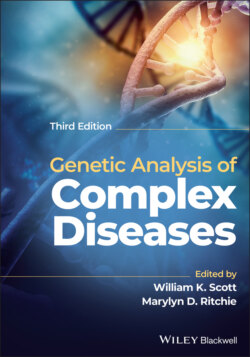Читать книгу Genetic Analysis of Complex Disease - Группа авторов - Страница 77
Recurrence Risk in Relatives of Affected Individuals
ОглавлениеA trio of seminal manuscripts in complex genetic analysis, published by Neil Risch (1990a, b, c), evaluated methods for linkage analysis and determining the mode of inheritance of disease loci using affected relative pairs. The basis for these analyses is familial recurrence risk ratios (λR):
(3.3)
A greater risk for disease in the relatives (of type R) of an affected individual compared with the risk in the general population is consistent with the involvement of genetics in the disease etiology. Because λR is a ratio, usually any value over 1.0 is considered to provide evidence for the involvement of a familial component/genetics in a condition. It is generally accepted that the larger the recurrence risk ratio, the stronger the role of genetics in the disease etiology. But this does not always hold true. Notice that the denominator in Equation (3.3) is the risk of the condition in the general population. Thus, for some common diseases, λR is not large but that is due to the high frequency of the condition in the general population, not due to the lack of the involvement of genetics. For example, λsibling = 4 – 5 for Alzheimer disease (Roses et al. 1995) compared with λsibling = 100 for autism spectrum disorder (Bolton et al. 1994; Bailey et al. 1995). In both of these complex disorders, genetics plays a significant role, but the frequency of Alzheimer disease in the general population is much higher than that of autism spectrum disorder, which contributes to the difference in the λsibling values. Recurrence risk ratios are also population‐specific as the disease risk in the general population may vary by ethnicity or geographic location. Keep in mind that a high λR could result from a common familial environment rather than genetics.
Risch (1990a) also demonstrated that the drop‐off in recurrence risk by degree of familial relation is related to the mode of inheritance. For a single‐gene model, λR –1 is expected to decrease by a factor of 2 with each decreasing degree of relation. For a multiplicative model, λR –1 will drop off more quickly with each degree of relation. Thus, by comparing the λR for various types of relatives, one can determine if the disorder is consistent with a particular inheritance pattern. Brown et al. (2000) found that the recurrence risks for ankylosing spondylitis were 8.2% for first‐degree relatives, 1.0% for second‐degree relatives, and 0.7% for third‐degree relatives. Because this drop‐off rate is more rapid than a factor of 2, a single‐gene model for genetic susceptibility to ankylosing spondylitis is not likely. Using the information on recurrence risks, the authors determined that the most likely mode of inheritance for ankylosing spondylitis was an oligogenic model with a multiplicative interaction between the loci.
One can also use recurrence risks to make a rough estimate of the number of genes involved in a disorder if one assumes a particular inheritance pattern. For example, the λsibling = 100 for autism spectrum disorder (Bolton et al. 1994; Bailey et al. 1995). It is clear that autism spectrum disorder does not follow a Mendelian mode of inheritance, and in fact, is more consistent with an epistatic interaction of multiple loci (Jorde et al. 1991). If we assume that there are four genes contributing an equal, additive effect to the genetic susceptibility, the λsibling for each locus would be 25 (25 + 25 + 25 + 25 =100). If there are four genes contributing an equal multiplicative effect, the λsibling for each locus would be approximately 3.2 (3.2 * 3.2 * 3.2 * 3.2 = 105). This type of information may be useful in determining the power to detect loci in a data set. That is, with a sample size of 100 sibpairs, the power to detect linkage at a locus with λsibling = 3.0 is about 85%, and the power to detect linkage at a locus with λsibling = 25 would be approaching 100% (Risch 1990b, figure 1). Thus, in this particular case, under either the additive or multiplicative model, one should have sufficient power to detect loci with 100 sibpairs.
